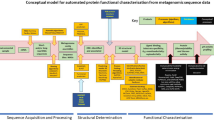Abstract
Ever since the publication of Darwin’s Origin of Species, questions have been raised about whether enough time has elapsed for living organisms to have reached their present level of complexity by mutation and natural selection. More recently, it has become apparent that life originated very early in Earth’s history, and there has been controversy as to whether life originated in a hot or cold environment. This review describes evidence that rising temperature accelerates slow reactions disproportionately, and to a much greater extent than has been generally recognized. Thus, the time that would have been required for primordial chemistry to become established would have been abbreviated profoundly at high temperatures. Moreover, if the catalytic effect of a primitive enzyme (like that of modern enzymes) were to reduce a reaction’s heat of activation, then the rate enhancement that it produced would have increased as the surroundings cooled, quite aside from changes arising from mutation (which is itself highly sensitive to temperature). Some nonenzymatic catalysts of slow reactions, including PLP as a catalyst of amino acid decarboxylation, and the CeIV ion as a catalyst of phosphate ester hydrolysis, have been shown to meet that criterion. The work reviewed here suggests that elevated temperatures collapsed the time required for early evolution on Earth, furnishing an appropriate setting for exploring the vast range of chemical possibilities and for the rapid evolution of enzymes from primitive catalysts.








Similar content being viewed by others
References
Wolfenden R (1972) Analog approaches to the transition state in enzyme reactions. Accts Chem Res 5:10–18
Kahne D, Still WC (1988) Hydrolysis of a peptide bond in neutral water. J Am Chem Soc 10:7529–7534
Radzicka A, Wolfenden R (1996) Rates of uncatalyzed peptide bond hydrolysis in neutral solution and the transition state affinities of proteases. J Am Chem Soc 118:6105–6109
Bryant RAR, Hansen DE (1996) Direct measurement of the uncatalyzed rate of hydrolysis of a peptide bond. J Am Chem Soc 118:5498–5499
Radzicka A, Wolfenden R (1995) A proficient enzyme. Science 267:90–93
Lad C, Williams NH, Wolfenden R (2003) The rate of hydrolysis of phosphomonoester dianions and the exceptional catalytic proficiencies of protein and inositol phosphatases. Proc Natl Acad Sci USA 100:5607–5610
Thompson W (1871) (Lord Kelvin) On the origin of life. Popular lectures and addresses. Macmillan, London, pp 197–205
Schopf JW (2006) Fossil evidence of Archaean life. Philos Trans R Soc B 361:869–885
Harcourt AV, Essen WT (1866) On the laws of connexion between the conditions of a chemical change and its amount. Philos Trans R Soc Lond 157:117–137
Roughton FJW (1941) The kinetics and rapid thermochemistry of carbonic acid. J Am Chem Soc 63:2930–2934
Stockbridge RB, Lewis CA Jr, Yuan Y, Wolfenden R (2010) Impact of temperature on the time required for the establishment of primordial biochemistry, and for the evolution of enzymes. Proc Natl Acad Sci USA 107:22102–22105
Woese K (1987) Bacterial evolution. Microbiol Rev 51:221–271
Di Giulio M (2003) The late stage of genetic code structuring took place at high temperature. Gene 261:189–195
Risso VA, Gavira JA, Mejia-Carmona DF, Gaucher EA, Sanchez-Ruiz JM (2013) Hyperstability and substrate promiscuity in laboratory resurrections of Precambrian β-lactamases. J Am Chem Soc 135:2899–2902
Snider MG, Temple BS, Wolfenden R (2004) The path to the transition state in enzyme reactions: a survey of catalytic efficiencies. J Phys Org Chem 17:586–591
Wolfenden R, Snider M, Ridgway C, Miller B (1999) The temperature dependence of enzyme rate enhancements. J Am Chem Soc 121:7419–7420
Zabinski RF, Toney MD (2001) Metal ion inhibition of nonenzymatic pyridoxal catalyzed decarboxylation and transamination. J Am Chem Soc 133:193–198
Bracken K, Moss RA (1997) Remarkably rapid cleavage of a model phosphodiester by complexed cerium ions in aqueous micellar solutions. J Am Chem Soc 119:9323–9324
Maldonado AL, Yatsimirsky AK (2005) Kinetics of phosphodiester cleavage by differently generated cerium (IV) oxo species in neutral solution. Org Biomol Chem 3:2859–2867
Sievers A, Beringer M, Rodnina MV, Wolfenden R (2004) The ribosome as an entropy trap. Biochemistry 101:7897–7901
Schroeder GK, Wolfenden R (2007) The rate enhancement produced by the ribosome: an improved model. Biochemistry 46:4037–4044
Author information
Authors and Affiliations
Corresponding author
Rights and permissions
About this article
Cite this article
Wolfenden, R. Primordial chemistry and enzyme evolution in a hot environment. Cell. Mol. Life Sci. 71, 2909–2915 (2014). https://doi.org/10.1007/s00018-014-1587-2
Received:
Revised:
Accepted:
Published:
Issue Date:
DOI: https://doi.org/10.1007/s00018-014-1587-2




